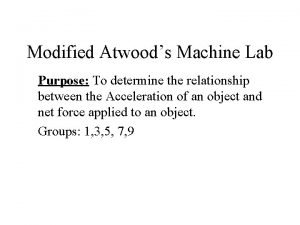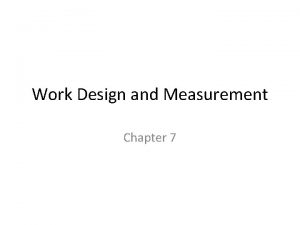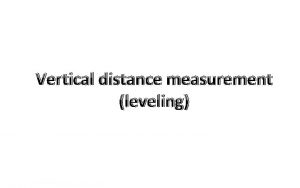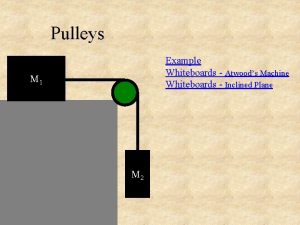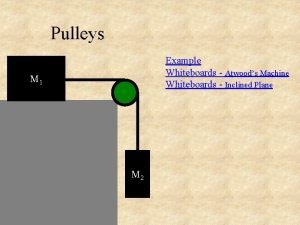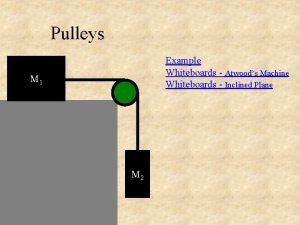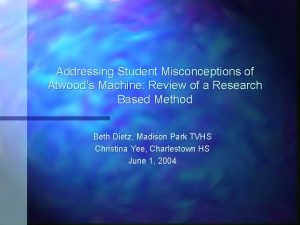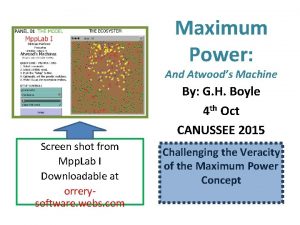Measurement of g Atwoods Machine Atwoods Machine Outline














- Slides: 14

Measurement of ‘g’ Atwood’s Machine Atwood's Machine

Outline l Measurement of ‘g’, – – – l Present Day equipment, – – l Early attempts, ‘Dilution’ of Gravity, Atwood’s Machine. Correction terms, Expressed as a straight line graph. Procedure, – – – Starting mechanism, Electrical Connections, Timing Mechanism. Atwood's Machine

Early attempts l Galileo 1564 -1642 – – – born and studied in Pisa professor of mathematics at Padua reputed to have dropped objects off the Leaning Tower. establishing acceleration is independent of the mass. but could not measure it accurately 55 m tall 3. 5 seconds to drop Atwood's Machine

‘Diluting’ Gravity • To slow down the rate of descent • Galileo used an inclined plane, • Could then get reasonable accuracy • using a ‘water clock’ • water pouring out of a beaker into a graduated flask. • Showed that the distance a ball rolls, d=½at 2 • Still difficult to measure ‘a’ accurately Atwood's Machine

Atwood’s Machine ‘dilutes’ gravity • Rev. George Atwood (1746 -1807) • tutor at Trinity College, Cambridge • set-up the demonstration experiment that today bears his name. • used a very light pulley on a light axle • supported each end of the axle • on the rim of two other wheels • to reduce friction in the bearings. Dilution factor Atwood's Machine

Present –day experiment l l l Two unequal weights joined by a light inextensible string Solenoid magnet and microswitch used to time the fall ( or rise) of the masses. Two differences – – l 1) Uses a ‘heavy’ pulley wheel. 2) With friction in the bearings. Have to correct for these effects. Atwood's Machine

Including the correction factors Correction factors Acceleration found by Inertia (I) of heavy pulley, r is radius of pulley Friction in the bearings G Expressed as a torque (r x Ff) Atwood's Machine

Equation of a straight line…. . Plot Dm against 1/t 2 Measure t (secs) for different values of m m = m 1 -m 2 (grams) M = m 1+m 2 (grams) n. b. hold constant = a x + y b h is measured (metres) and held constant I/r 2 = 80 grams gradient intercept G can be found from the intercept Atwood's Machine

Procedure l Start by weighing the washers and the weights, – – – l Assemble onto the line and fit over pulley, – – l all washers plus weights together = M, weigh 10 washers and divide by ten to find average the change, m, is twice the weight of one washer. Measure height - h, that mass will rise, Measure radius – r, of pulley ( half diameter). N. B. when adding or removing washers, rest the other mass on the bench Atwood's Machine

Starting mechanism l Electromagnet restrains the weights – – l until you are ready to start timing Press switch to release weights and start the timer. N. B. One weight has an iron insert. – – Make sure it’s over the electromagnet, Set this one to be the lighter of the two Atwood's Machine

Electrical connections l l Plug electromagnet cable (grey) into MAGNET socket of electronic clock, N. B. beware of Mains (110 v) voltage – l l l Don’t touch bare wires…… Connect the brown cable between the micro-switch terminal at the base of the pole, and the EXT. STOP of the electronic clock. Solenoid platform should be as low as possible, Plug in the micro-switch lead at the top of the pole Atwood's Machine

Electronic Timing l Set the clock as follows – – – l Set the leftmost switch to ON Set the rightmost switch to EXT. STOP Set the power switch (at side) to ON Reset the clock ( electromagnet will be activated) Press the remote switch to start the timer and release the weights Reset clock after each cycle N. B. make sure string and weights don’t touch the bench or the supports during the movement. Atwood's Machine

Go to it……. . l l l l Start weighing the masses, Assemble the string and pulley Make sure the string is long enough Measure the distance to rise Connect the electrical wires Switch on and take a sample measurement, Make sure the pulley system doesn’t snag on the bench-top or support pole. Atwood's Machine

l The end Atwood's Machine
 Modified atwood machines
Modified atwood machines Sandwich paragraph example
Sandwich paragraph example Finite state machine vending machine example
Finite state machine vending machine example Mealy and moore machine
Mealy and moore machine Moore machine to mealy machine
Moore machine to mealy machine Energy work and simple machines chapter 10 answers
Energy work and simple machines chapter 10 answers Measurement ladder
Measurement ladder Chapter 7 work design and measurement
Chapter 7 work design and measurement Level of measurement in statistics
Level of measurement in statistics Gallon man chart
Gallon man chart Weather measurement tools
Weather measurement tools Silvermans closest speaking space
Silvermans closest speaking space Vertical distance measurement in surveying
Vertical distance measurement in surveying How to measure jvp clinically
How to measure jvp clinically International measurement system
International measurement system
